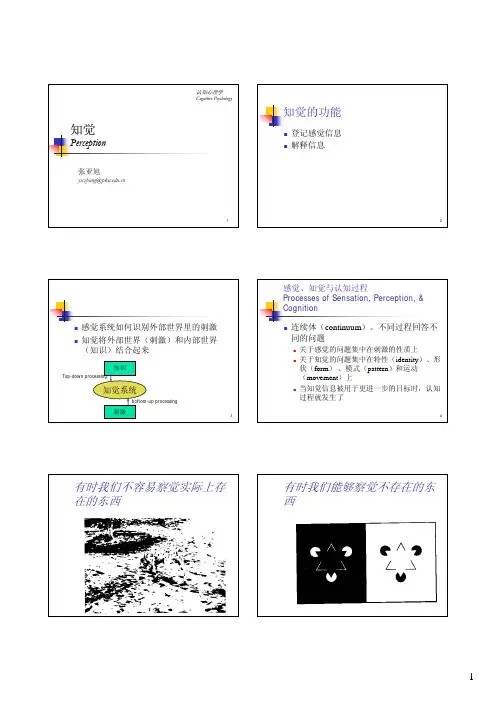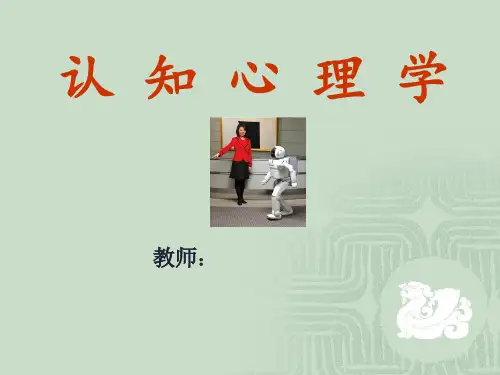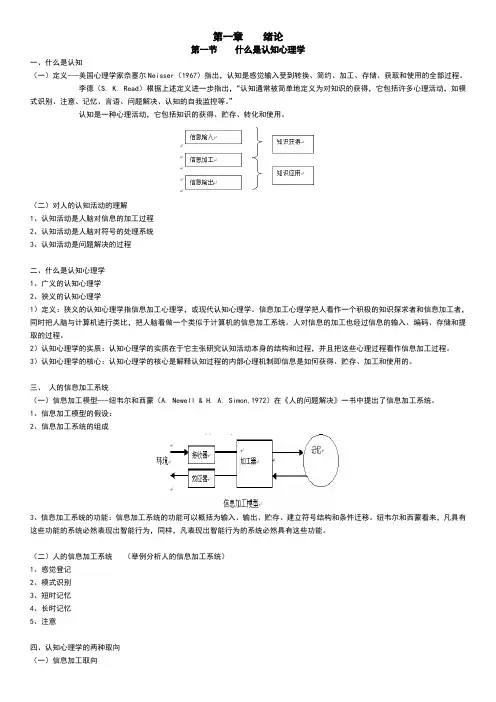认知心理学课件09:概念与分类
- 格式:ppt
- 大小:507.50 KB
- 文档页数:29


知觉的功能知觉PerceptionProcesses of Sensation, Perception, &Cognition有时,我们能够察觉不可能存在的东西7视觉模式识别((模板匹配模型((与模板理论相比,特征模型的优点混战场模型(整体优先效应Global Precedence Effect (Navon, 1977)Kinney特征理论的生理学和神经学证据Gibson, 1969任务:两个字母相同还是不同?V1 LGN What 和Where 通路计算途径(Biederman et al ., 1985Biederman et al ., 1985无字数要求,提交打印纸质版截止时间:30Bottom 知识、期望31Biederman et al ., 197332Schacter Key Themes of Cognitive PsychologyObject PerceptionThe gestalt principles of organizationPalmer, 1977Face PerceptionFaces: The fascinating test case for many of the Questions on Face Processing Questions on Face ProcessingMargaret Thatcher illusionRotate this!Thompson, 1980Thompson, P. (1980). Margaret Thatcher: A new illusion.Perception, 9(4), 483-484Rotate this!Processing45Nonhuman primate species alsoexhibits the Thatcher effectAdachi, I. et al. (August 11, 2009). Thatcher effect in monkeys demonstratesconservation of face perception across primates. Current Biology, 19, 1270-1273Adachi, I. et al. (August 11, 2009). Thatcher effect in monkeys demonstratesconservation of face perception across primates. Current Biology, 19were presented in 5153Within-items design舒华, 张亚旭. (2008). 心理学研究方法:实验设计和数据分析. 北京:人民教育出版社Bottom line55The configural setThe featural setFace Processingthey had had at least nine years of visual experience after treatment before testingseverely impaired at differentiating faces that differed only in the spacing of their featuresnormal in distinguishing those varying only in the shape of individual featuresFarah 59Tanaka & Farah, 1993Study phaseassociate names with faces or housesTest phaseforced choice (part vs. whole condition)Resultsno difference between the whole and part conditions for housesperformance in the whole condition was much better than in the part condition for facesConclusionObject recognition is analytic and part-based, whereas face recognition is holistic and configuralIdentity(actor/non-actor) vs. gender discrimination [12]Viewing faces vs. non-sensepictures [33, 32]Viewing faces vs. non-face objects [6, 7]61The Models of Face Recognition63Neural System for Face Perception ( et al65666768 de GelderSelf Face Recognition72Keenan et al. 2000.Neuropsychologia, 38, 1047-1053Results Questions for this Lecture ReferencesReferences。




第一章绪论第一节什么是认知心理学一、什么是认知(一)定义---美国心理学家奈塞尔Neisser(1967)指出,认知是感觉输入受到转换、简约、加工、存储、获取和使用的全部过程。
李德(S. K. Read)根据上述定义进一步指出,“认知通常被简单地定义为对知识的获得,它包括许多心理活动,如模式识别、注意、记忆、言语、问题解决、认知的自我监控等。
”认知是一种心理活动,它包括知识的获得、贮存、转化和使用。
(二)对人的认知活动的理解1、认知活动是人脑对信息的加工过程2、认知活动是人脑对符号的处理系统3、认知活动是问题解决的过程二、什么是认知心理学1、广义的认知心理学2、狭义的认知心理学1)定义:狭义的认知心理学指信息加工心理学,或现代认知心理学。
信息加工心理学把人看作一个积极的知识探求者和信息加工者,同时把人脑与计算机进行类比,把人脑看做一个类似于计算机的信息加工系统。
人对信息的加工也经过信息的输入、编码、存储和提取的过程。
2)认知心理学的实质:认知心理学的实质在于它主张研究认知活动本身的结构和过程,并且把这些心理过程看作信息加工过程。
3)认知心理学的核心:认知心理学的核心是解释认知过程的内部心理机制即信息是如何获得、贮存、加工和使用的。
三、人的信息加工系统(一)信息加工模型---纽韦尔和西蒙(A. Newell & H. A. Simon,1972)在《人的问题解决》一书中提出了信息加工系统。
1、信息加工模型的假设:2、信息加工系统的组成3、信息加工系统的功能:信息加工系统的功能可以概括为输入、输出、贮存、建立符号结构和条件迁移。
纽韦尔和西蒙看来,凡具有这些功能的系统必然表现出智能行为,同样,凡表现出智能行为的系统必然具有这些功能。
(二)人的信息加工系统(举例分析人的信息加工系统)1、感觉登记2、模式识别3、短时记忆4、长时记忆5、注意四、认知心理学的两种取向(一)信息加工取向主要观点:许多认知过程是以系列和序列的方式进行的。




